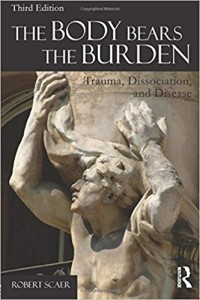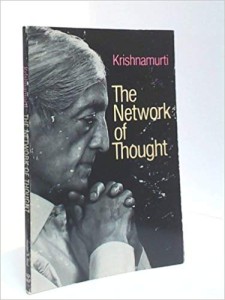 There are two books on my mind as of late: “The Network of Thought” by Krishnamurti, and ‘The Body Bears the Burden” by Robert Scaer, M.D..
There are two books on my mind as of late: “The Network of Thought” by Krishnamurti, and ‘The Body Bears the Burden” by Robert Scaer, M.D..
Krishnamurti was the consummate jnana yogi whose engaging dialogues with his students/audience are well documented in many of his books. The basic premise of ‘The Network of Thought” is that ‘thought’ or thinking is like the limited programming of a computer, and throughout history, humans have been programmed to create a self sense through thought. I am a Hindu, I am a Buddhist, I am an atheist, I am a liberal … whatever flavor the culture of your time and place may provide, an identity is created and sustained.
 If we look more deeply, as Krishnamurti would advise, we can see that thought creates all of what passes for ‘reality’ in our experience. Words, the language of thought, are abstractions that are highly limited at best. When reality ‘rooted in abstraction’ is mistaken for the ‘Ultimate Mystery’ of Reality, fear, anxiety and conflict inevitably arise, within oneself, and within the larger communities we find ourselves. “I am inadequate/flawed/unworthy/fill in your favorite inner commentary” always sit in the background, conscious or non-conscious, driving the bus of our lives.
If we look more deeply, as Krishnamurti would advise, we can see that thought creates all of what passes for ‘reality’ in our experience. Words, the language of thought, are abstractions that are highly limited at best. When reality ‘rooted in abstraction’ is mistaken for the ‘Ultimate Mystery’ of Reality, fear, anxiety and conflict inevitably arise, within oneself, and within the larger communities we find ourselves. “I am inadequate/flawed/unworthy/fill in your favorite inner commentary” always sit in the background, conscious or non-conscious, driving the bus of our lives.
From the perspective of the skandhas, words and abstraction are the foundations of skandha number 2. Here, when the small self glimpses the infinite and the recognizes that it too is impermanent, it spins a web of delusion known as likes and dislikes, or raga and dvesa as they are called in the Yoga Sutras. Life then becomes an endless pursuit to escape difficulty and acquire pleasure. On the surface, avoiding unpleasantness and finding pleasure make all kinds of sense. The problem is that if this is the whole story of your life, then there is no escape from the deep sense of unease that stems from the reduction of your infinite potential to an endless series of abstractions. To open to Ultimate Mystery, to open to an infinite ocean of creativity, love and wisdom, you have to change your fundamental orientation to impermanence.
The Zen Poem, Hsin Hsin Ming, (read the whole poem here), attributed to the Chinese Zen Master Seng T’san and written somewhere in the 6th – 8th centuries CE, is an exquisite unfolding of this insight. This translation of the first few verses is from Elliott Teters, and I prefer this one because many translators use ‘love and hate’ in line two instead of longing and desire. From my perspective, love is a word pointing to non-dual wholeness and completeness and is not the opposite of hatred or aversion. Longing or grasping capture the essence more accurately.
The Great Way is not difficult for those who have no preferences.
Let go of longing and aversion and it reveals itself.
Make the smallest distinction, however and you are as far from it as heaven is from earth.
If you want to realize the truth then hold no opinions for or against anything.
Like and dislike is the disease of the mind.
When the deep meaning (of the Way) is not understood
the intrinsic peace of mind is disturbed.
As vast as infinite space it is perfect and lacks nothing.
Indeed, it is due to your grasping and repelling
That you do not see things as they are.
Do not get entangled in things;
Do not get lost in emptiness.
Be still in the oneness of things and dualism vanishes by itself.
The Great Way, Ultimate Mystery, or Truth, is uncapturable in words, imagery, ideas or beliefs, but can be seen directly in the silence of meditation when thought, temporarily, pauses. Pause – Relax – Open – Allow.
The last few verses from Seng T’san:
Emptiness here, Emptiness there, but the infinite universe stands always before your eyes.
Infinitely large and infinitely small;
no difference, for definitions have vanished and no boundaries are seen.
So too with Being and Non-Being.
Don’t waste time with doubts and arguments that have nothing to do with this.
One thing, all things: move among and intermingle, without distinction.
To live in this realization is to be without anxiety about non-perfection.
To live in this faith is the road to non-duality, because the non-dual is one with trusting mind.
Words! Words!
The Way is beyond language,
for in it there is no yesterday, no tomorrow, no today.
“The Body Bears the Burden” is about trauma and its effects on psychology, physiology and brain function. As a neurologist, Robert Scaer ties together the research done by trauma pioneers like Peter Levine and Bessel Van de Kolk and others with his own clinical experience to unfold the hidden side of trauma in all of its many manifestations. And there is always a ‘story’ entangled in the trauma, usually one filled with self-recrimination and shame, as well as fear. Words entangled in the trauma!
What is fascinating to me is that my own personal experience with PTSD, triggered by the Thomas Fire which surrounded Ojai last December, is being re-triggered by my various encounters with the medical world, and this began before the cancer diagnosis. I had a challenging childbirth, in a hospital, with some medical intervention to the natural process, so it is not surprising that I have some issues to work through here. When my PTSD is activated, the physiological ‘freeze’ response, where the accelerator and brake of my autonomic nervous system are being activated simultaneously, is also accompanied by a ‘network of thought’ layered with meaning making interpretations.
Fear, anxiety and shame are my three big ones and they are entangled in this body/mind web of physiology and thought. So I have to dis-entangle the physiological energy trapped in a holding pattern from the story attached to it for true healing to take place. This is not pleasant or easy and my first response is always ‘take this away .. get me out of here’. This only makes it worse.
One of the challenges of a somatic meditation practice is that the body stores trauma, large and small, as as you move into more and more openness, you are liable to uncover some un-resolved or blocked energy. When the story is activated, it tends to re-stimulate the trauma, creating a self-perpetuating feed back loop. Often the response oscillates between hyper arousal/fear and dissociation, dissociation being the ‘escape’.
In ‘Somatic Experiencing’, the trauma resolution therapies based on Peter Levine’s study of mammals in the wild, healing requires the building of somatic resources that can contain, process and integrate the bound energy without the activation of the self-perpetuating loop. Titrating, or taking one or two drops of trauma energy at a time to resolve, while sustaining an energetically stable and flexible state (sthira and sukham) is done with the help of a trained SE practitioner who helps hold the fluid/stable space.
Meditation practice allows one to be both the therapist and the client, as the spaciousness is a primary resource. It begins as a ‘witnessing’ of what is arising, which is all well and good if random thoughts are all that arise. But when you open to a traumatic energy pattern, your sthira and sukham are seriously challenged. Gravity and coming into the felt sense of weight in the body is another resource, the yin to the spacious yang. Does the energy want to descend into the earth and discharge there? Are your bones alive and vital? Mother Earth’s energy field can handle our physiological energy easily if we can learn to drop into her. Does the energy want to expand up and out, into the sky, the heavens, the sun, moon, stars and planets? All can offer healing to us. The Qi wants to move, in harmony with heaven and earth. We are heaven and earth.
At some point, heaven and earth, yin and yang, weight and lightness dissolve into wholeness, not two-ness. And then the terrifying abyss of impermanence also dissolves, for the time being. Until the next trauma is triggered. We all need trigger warnings! The abyss of impermanence is terrifying. Only the strategy is not to avoid facing it, but to see it is ultimately based on being afraid of our own mental creations, our own abstractions.
The body bears the burden of our confusion by locking down energy, but it also offers a way to freedom. The body is an expression of Divine wholeness, even as it flows through and as continuous impermanence. It thrives on impermanence, which allows the organismic intelligence to grow and relate and evolve. Falling down is OK. Being lost and confused is OK. The depths of love, wisdom and creativity are always present, in all situations. We just have to remember. Being without anxiety about imperfection! Impermanence as a path to healing. Wow. How delightful. What a great story! How challenging!
One thing, all things: move among and intermingle, without distinction.
To live in this realization is to be without anxiety about non-perfection.
To live in this faith is the road to non-duality, because the non-dual is one with trusting mind.

